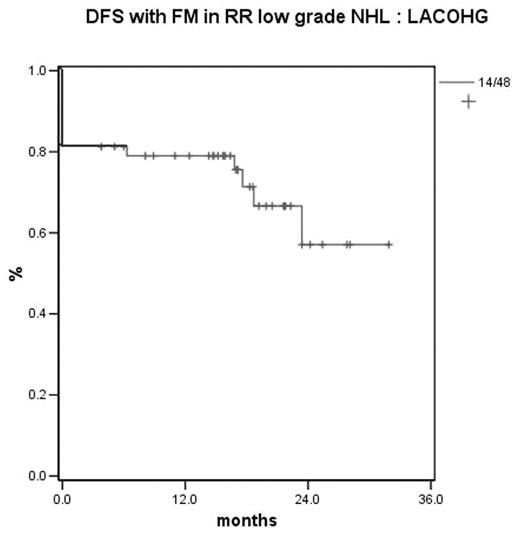Abstract
Background: fludarabine (F) is licensed for the management of indolent non Hodgkin’s lymphoma in countries such as Canada and Switzerland. Clinical evidence suggests that fludarabine monotherapy is as least as effective, than conventional therapies such as cyclophosphamide, vincristine, prednisone (CVP) for the first and second line treatment of B-cell low grade NHL achieving objective response rates. Better response rates can be achieved combining F with Mitoxantrone (M) in low grade NHL even in refractory relapsed (RR) patients (pts). The Latin American Cooperative Oncology Hematology Group (LACOHG) proposed a multicenter study in Latin American countries in 2002 to use FM in RR B-cell low grade NHL.
Aims: to assess the response rate, safety, disease free survival (DFS) and overall survival (OS) of FM in RR B-cell low grade NHL during (2003–2006).
Methods: Forty-eight patients in the period of January 2003 to February 2006 were evaluated. Forty-four pts. had follicular lymphoma and 4 small lymphocytic lymphoma. Median age 63.5 years old (range: 24–83). Gender: female 56% and male 44%. Inclusion criteria for low grade NHL-LG was: any previous treatment excluding autologous transplantation, Ann Arbor stage II to IV, age > 18 years old, ECOG performance status 0–2 and written informed consent. ECOG performance status 0: 2%, 1: 71% and 2: 27%. Ann Arbor staging: II: 2%, III: 29% and IV: 69%. International Prognostic Index (IPI): 0–1: 19%, 2–3: 71% and 4–5: 10%. Median previous treatment was 1 (range: 1–3). FM treatment consisted of F 25 mg/m2 i.v. (day 1–3) and M 10 mg/m m2 i.v. (day 1) each 28 days for 6–8 cycles.
Results: on this low grade NHL cohort the overall response rate (ORR was 81%; progressive disease and non-response 19%. With a median follow up of 17 months, OS at 24 months was 86% (DE 5.2%) and DFS at 24 months 57.1% (DE 11.3%). LDH in serum was not an adverse prognostic factor for DFS and OS.
Safety: on the 286 cycles in 48 pts, the toxicity was: 18 episodes of grade 3-4 neutropenias, 15 episodes of grade 3-4 thrombocytopenia, 7 episodes of grade 1–2 nausea/vomiting, grade 1–2 diarrhea in 4 pts, 8 pts were admitted to the clinic, 11 fever episodes, 2 allopecia, 4 pts developed grade 1–2 peripheral neuropathy and infections 7%: one case herpes zoster.
Mortality rate: 12,5% (6/48 patients), 5 of them because progressive disease. No cardiac toxicity was reported.
Conclusions: FM is an effective and safe treatment for RR low grade NHL. A longer follow up and a larger trial, might be needed to confirm these results in a multicenter, randomized study.
DFS with FM in RR low grade NHL : LACOHG
Disclosure: No relevant conflicts of interest to declare.
Author notes
Corresponding author


